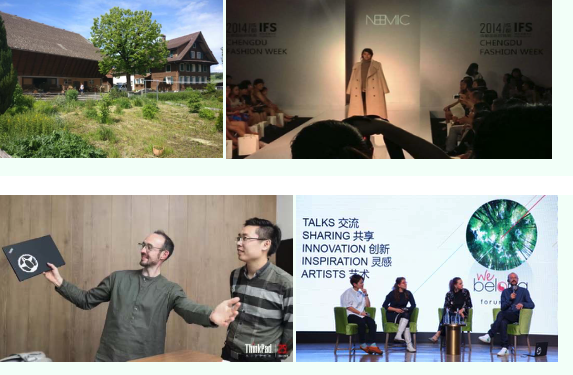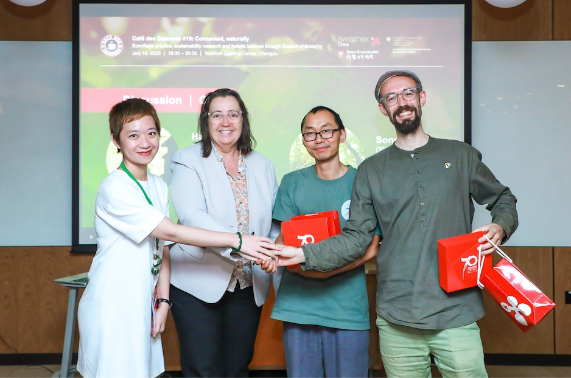By Cissy Sun, Head of Art-Science
On 11 August, the final edition of Art x Science Dialogues: Bridging the Future – New Interdisciplinary Initiatives was held via Zoom. Prof. Sarah Kenderdine, Director of Laboratory for Experimental Museology (eM+) & ArtLab EPFL, Ms. Maximiliane Okonnek, Managing Director of ETH Library Lab, and Prof. Zhijie Qiu, Dean of the School of Experimental Art of CAFA shared with us their art-science practices and also had a collaborative discussion on the opportunities and challenges in building up such initiatives.
We trust that everyone has acquired informative insights on the topic. Due to the time constraint, we could only present a limited number of questions. If you have further questions for our speakers regarding their respective new interdisciplinary initiatives, please email us at artscience@swissnexchina.org. We will try our best to forward them to the speakers.
The webinar recording is available to view and download here.
The webinar slides are available to download here.
Here are some key event takeaways that we would like to share with you.
Research and projects at eM+ & ArtLab EPFL
eM+ is a new transdisciplinary initiative at the intersection of immersive visualisation technologies, visual analytics, aesthetics and cultural (big) data. eM+ engages in research from scientific, artistic and humanistic perspectives and promotes post-cinematic multisensory engagement using experimental platforms. It has 8 unique visualisation systems combined with powerful sonic architectures that are benchmarks in the realms of virtual, augmented, mixed realities.These cluster-based 3D systems have been deployed in major exhibitions and installations throughout the world.
Attached to the EPFL College of Humanities (CdH), ArtLab presents temporary and long-term exhibitions that bring the world of science and the Humanities closer together. It also houses a Montreux Jazz Café in which it is possible to consult the festival’s audio-visual archives.
Jazz Luminaries is an interactive fulldome installation featuring 5400 artists of Jazz, Blues, and Latin music connected through more than 30 800 links. Reclined under the fulldome in a hemispheric gestalt, participants unfold an experience based on the social network constellations of jazz luminaries from the Montreux Jazz Archive. This installation based on the UNESCO Memory of the World collection, digitised at EPFL, cuts, remixes and replays 5’400 jazz greats and over 13’000 videos.
The Hong Kong Martial Arts Living Archive is a longitudinal research project, initiated in 2012 in collaboration with the International Guoshu Association, City University of Hong Kong, and the Laboratory for Experimental Museology (eM+), Digital Humanities Institute, EPFL. The project encompasses the first-ever comprehensive digital strategy of archiving and annotating a living kung fu tradition using state-of-the art data capture tools. In addition, this archive will become the wellspring of exhibitions and installations that promulgate rich cultural traditions.
ETH Library Lab
The ETH Library Lab is a joint initiative of ETH Library and the Library of Karlsruhe Institute of Technology (KIT). It started its operations in the middle of 2018.
ETH Library Lab strives to advance information infrastructure and services for science, research and education. By boosting related ideas, practices and strategies, the initiative contributes to future scientific work environments.
The ETH Library Lab Innovator Fellowship support for visionary talents. The Lab welcomes thinkers and doers, whose ideas have the power to reshape workflows and information environments for the future of science. As an Innovator Fellow you will be able to bring your idea to prototype level backed by inspiring mentors, experts and scientists. The fellowship program is open to international applicants, and the call is currently on for the next year. (Click here to read more)
Beneath the Sea – a Multidisciplinary Journey is one of the projects that supported by the fellowship program. Beneath the Sea aims to develop an optimized structure to host coral larvae and marine organisms. The project goal was to create a prototype for an artificial reef structure made of sustainable material and using digital fabrication methods.
Art-Science Practices of Prof. Qiu at CAFA
In collaboration with JD Artificial Intelligence Lab, Prof. Qiu has conducted several AI & art projects. One of them was a novel real-time, collaborative, and interactive AI painting system, Mappa Mundi, for artistic Mind Map creation. The system consists of a voice-based input interface, an automatic topic expansion module, and an image projection module. The key innovation is to inject Artificial Imagination into painting creation by considering lexical and phonological similarities of language, learning and inheriting artist’s original painting style, and applying the principles of Dadaism and impossibility of improvisation.
He also trained an AI artist – Xia Yubing together with Microsoft Asia Research Institution. The AI artists was trained to learn how to draw by studying the work of hundreds of artists. Most are based on the post-impressionist and early modernist movements, explained Prof. Qiu. The artworks of Xia Yubing were presented at the graduation exhibition at CAFA 2019 and the works are very well received by the audience. And now an app is developed that you may type in the keywords for the AI artist to generate paintings for you in a few minutes.
Apart from these projects, Prof. Qiu also initiated Education, Arts, Science & Technology (EAST) season at CAFA in 2017. During this season, there will be international conferences, exhibitions, workshops and visits. It’s been an important platform for exchanges and collaborations in art-science field.
Q & A Session
What are the impact of your initiatives of the host universities and what are the challenges of building up such initiatives and operating the projects?
K: If you have artists leading the vision together with scientists, you’ll have the potential innovations that otherwise will not be possible. And the thinking is very equivalent at EPFL, the university is very technical oriented but the recognition of creativity is fundamental to make it work. The ArtLab project was to make this relationship visible, and to tangibly connect art and humanity people to the science and tech community. It has a profound impact on the two communities to work together and the result is rewarding.
O: It is important at ETH Zurich to facilitate the students with an open, innovative platform that the students do not only focus on their own field. But talking about challenges, sometimes it is difficult to put people from different disciplines together, you’ll have to find the common ground and be familiar with their own languages from both sides and coordinate in between.
Q: At CAFA, I’m still trying to build up the ecological system of art-science. In China, people talk about media/new media art a lot for the past 20 years, but it is too narrow if you only focus on that. And I’m trying to build up the concept of science & technological art instead of media/new media art for our students. They should be aware of biotech, earth science, advanced math etc. and I’m happy to see that in recent years, the scientists, big companies in China start to recognise the importance of art and they are open to collaborate in art-science projects.











































